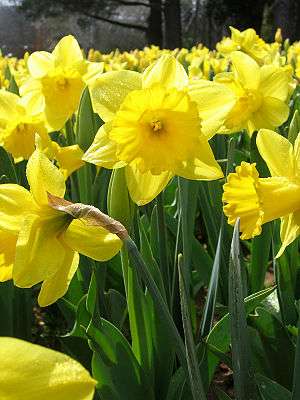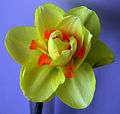Narcissus
< Horticulture| Narcissus | |
|---|---|
 | |
| Genus: | Narcissus |
| Family: | Amaryllidaceae |
| Type: | Perennial bulbs |
| Soil requirements: | Dry in summer |
| Propagation: | Offsets |
| Pest issues: | Uncommon |
| Disease issues: | Uncommon |
| Pollination: | Insect |
Narcissus is the Latin name for a group of hardy, mostly spring-flowering, bulbs. There are several Narcissus species that bloom in the autumn. Daffodil is the common English name for all narcissus. The botanic name of the genus is Narcissus. They are mostly native to the Mediterranean region, but a few species are found through Central Asia to China. The range of forms in cultivation has been heavily modified and extended, with new variations available in nurseries practically every year.
The name Narcissus is derived from that of the narcissistic youth of Greek mythology, Narkissos. Though "Narcissi" is sometimes given in dictionaries as the grammatically correct plural of "Narcissus", The American Daffodil Society prefers the use of "narcissus" for both singular and plural. (the Webster's Third New International Dictionary gives "narcissus", "narcissuses" and lastly "narcissi" as plural forms)
The name Daffodil is derived from an earlier "affodell", a variant of asphodel. The reason for the introduction of the initial "d" is not known, although a probable source is an etymological merging from the Dutch article "de," as in "de affodil". From at least the sixteenth century "Daffadown Dilly" or "daffadowndilly" has appeared as a playful synonym of the name.
Narcissus are sometimes called jonquils in North America, but strictly speaking that name belongs only to the rush-leaved Narcissus jonquilla and cultivars derived from it.
Paperwhites refer to the species Narcissus papyraceus.
Description
The flowers have a central trumpet-shaped corona surrounded by a ring of petals. The traditional daffodil has a golden yellow color all over, but the corona may often feature a contrasting color. Breeders have developed some daffodils with a double or triple row of petals, making them resemble a small golden ball. Other cultivars have frilled petals, or an elongated or compressed central corona.
The foliage is simple, straplike with linear veination, fleshy, juicy, hollow, more or less glaucus.
Daffodils are poisonous, and if eaten could result in death.[1]
Growing conditions
Moist, fertile, well-drained. To avoid disease problems do not irrigate in summer.
Types
The horticultural divisions include:
- Trumpet daffodils
- Large-cupped daffodils
- Small-cupped daffodils
- Double daffodils
- Triandrus daffodils
- Cyclamineus daffodils
- Jonquilla daffodils
- Tazetta (Poetaz or Bunch-flowered) daffodils
- Poeticus (Poet's) daffodils
- Bulbocodium daffodils
- Split-corona daffodils
- Other daffodils which don't fit the above divisions
- Species and wild hybrids
- Miniature daffodils are found in all divisions.
Species
- Narcissus papyraceus
- Narcissus tazetta
Uses
Cut flowers.
The daffodil serves as the national flower of Wales. One species, Narcissus obvallaris, grows only in a small area around Tenby. In Wales it is traditional to wear a daffodil on Saint David's Day (March 1).
The flower is a common decoration flower during Chinese New Year.
Various Cancer Societies around the world use the Daffodil as fundraising symbol. "Daffodil Days" are organised to raise funds by offering the flowers in return for a donation. Is used to develop a large number of hybrids and cultivars. Modern daffodil cultivars are important ornamental crops. The bulb, leaf, and flower are used to make medicine. They are used for whooping cough, colds, and asthma. It is also used to the skin, to treat wounds, burns, strains, and joint pain.
Pests and diseases
Generally free of problems in good soil, but prone to diseases in wet soils. Mammal pests generally avoid this plant.
- Didymellinia macrospora
White Mold
- Ramularia vallisumbrosae
Decay (storage):
- Sclerotinia narcissicola
Blights, Scorch
- Stagonospora curtissii
- Sclerotinia polyblastis
Basal Rot
- Fusarium oxysporum var. narcissi
Crown Rot
- Pellicularia rolfsii
- Sclerotium delphinii
Bulb Rot
- Penicillium
- Sclerotinia narcissi
Root Rot
- Cylindrocarpon radicicola
Mosaic
- Narcissus Mosaic Virus
Flower Streak
White Streak
- Narcissus Silver Leaf Virus
Yellow Stripe
- Narcissus Yellow Stripe Virus
Root Lesion
- Pratylenchus
Stem and Bulb Rot
- Ditylenchus dispaci
- Tulip Bulb Aphid: Dysaphis tulipae
- Lesser Bulb Fly: Eumerus tuberculatus
- Narcissus Bulb Fly: Merodon equestris
- Convict Caterpillar: Xanthopastis timais
- Bulb Mite: Rhizoglyphus echinopus
- Bulb Scale Mite: Steneotarsonemus laticepi
Millipedes
- Orthomorpha gracilis
Gallery
-

White Jonquil
-

White Jonquil
-

Narcissus pseudonarcissus
-

Narcissus tazetta
-

Narcissus bulbocodium ssp. bulbocodium
-

Narcissus poeticus 'Actaea'
-

Narcissus 'Tahiti'
-
Narcissus (yellow)
References
- Christopher Brickell and Judith D. Zuk (1997). The American Horticultural Society A-Z Encyclopedia of Garden Plants. DK Publishing. pp. 689-696.
- Pirone, Pascal P. (1978). Diseases & Pests of Ornamental Plants (Fifth Edition ed.). John Wiley & Sons, New York. pp. 366-370.
- Cranshaw, Whitney (2004). Garden Insects of North America: The Ultimate Guide to Backyard Bugs. Princeton University Press. pp. 607.
- Pippa Greenwood, Andrew Halstead, A.R. Chase, Daniel Gilrein (2000). American Horticultural Society Pests & Diseases: The Complete Guide to Preventing, Identifying, and Treating Plant Problems (First Edition ed.). Dorling Kindersley (DK) Publishing, inc.. pp. 200.